
Researchers in Switzerland have built what they claim is the simplest microscope objective ever constructed. The device, which comprises just two optical components, is based on the classic Schmidt telescope design and works in a variety of immersion liquids as well as air. Because the new objective has a larger field of view and working distance than standard devices, the researchers say it could be used to image large organs and even whole organisms.
“Our work is a first step towards rethinking how future microscope objectives for high-throughput microscopy applications can be built,” says Fabian Voigt, who led the development team at the University of Zurich and is now a postdoctoral researcher at Harvard University in the US.
For the last century and a half, Voigt points out, most microscope objectives used in bio-imaging have been built with lenses. Mirror-based designs have largely been neglected, but they do have one great advantage: unlike conventional lens-based objectives, their behaviour does not depend on refractive index. This means that mirrors can be used to make so-called multi-immersion objectives that can produce a sharp image when immersed in many different liquids.
The Schmidt objective
Voigt and his colleagues at Zurich created their new mirror-based objective by mimicking the design of a much older instrument: the Schmidt telescope. This workhorse of astronomy consists of a spherical mirror and a refractive correction plate that counteracts aberrations introduced by the mirrors, and it delivers excellent images over a large field of view. “We have shrunk this telescope down to the size of a standard microscope,” Voigt explains.
Voigt and his colleagues say the resulting structure resembles the eyes of sea scallops, which use an immersed curved mirror to form images. The team used the new objective to image a variety of objects, including pollen grains in air, neuronal activity in zebrafish larvae in water and various “cleared” biosamples – that is, samples that have been made transparent so they are accessible to light microscopy – in organic solvents such as benzyl alcohol/benzyl benzoate, dibenzyl ether and ethyl cinnamate.

Expansion microscopy enables nanoimaging with a conventional microscope
The new objective, which the team call a Schmidt objective, has a high numerical aperture of 1.08 at a refractive index of 1.56, a field of view of 1.1 mm and a working distance of up to 11 mm. This combination of properties is rare in microscope objectives since devices with a high numerical aperture often lack the working distance required to reach features of interest deep inside a sample. This is especially true for cleared samples, which in recent years have increased significantly in size, to the extent that entire mouse bodies and whole human organs can now be cleared.
In principle, the Schmidt objective concept, which the team describe in Nature Biotechnology, could be extended to other imaging techniques such as wide-field, confocal and light-sheet microscopy, say the researchers. “To achieve this, we will have to correct aberrations over the entire visible spectrum,” Voigt acknowledges. “We believe this will be possible by combining the Schmidt objective with a custom tube lens.”



